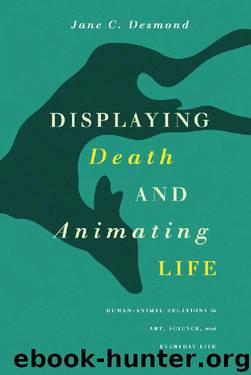Displaying Death and Animating Life: Human-Animal Relations in Art, Science, and Everyday Life (Animal Lives) by Jane C. Desmond

Author:Jane C. Desmond [Desmond, Jane C.]
Language: eng
Format: epub
ISBN: 9780226375519
Publisher: University of Chicago Press
Published: 2016-08-18T05:00:00+00:00
The Scope of the Phenomenon
It’s difficult to gather reliable evidence about how many animals currently paint in the United States, Europe, Southeast Asia, and Japan (the four geographic areas I am aware of with press reports of contemporary painting animals). Most of these instances stem from an individual trainer’s, owner’s, artist’s, or zookeeper’s initiative, as was the case with ratiste Tony Blair. However, anecdotal evidence is plentiful and can be gleaned from web links to sanctuaries, local press reports, articles on enrichment practices for captive animals in zoos and research facilities, oral reports from keepers and primatologists, and discussions on web forums among zookeepers and zoo scholars and aficionados, such as the Zoo Keeper’s discussion list of the Association of Zoos and Aquariums.
While I cannot confidently estimate the total number of animals painting in the United States today, it’s clear that the phenomenon is widespread and growing. By one estimate, about thirty elephants were painting in US zoos in the year 2000.10 Art making by a variety of animal species is taking place today at sites like the Oklahoma City Zoo and Botanical Garden, the Indianapolis Zoo, the Virginia Zoological Park, the Great Ape Trust in Des Moines, the M. D. Anderson Cancer Center Department of Veterinary Medicine and Surgery in Houston, the Woodland Park Zoo in Seattle, the Milwaukee Zoo, Jungle Friends Monkey Sanctuary in Florida, Chimp Haven in Louisiana, and the Wildlife Medical Clinic at the University of Illinois in Champaign-Urbana, to name just a few.
Paintings by animals clearly aren’t anything new, and some earlier celebrity animal “artists” have developed their own following. Ruby, an Asian elephant born in Thailand in 1974 and a longtime resident of the Phoenix Zoo, started painting as an enrichment exercise in 1987, to give her something stimulating to do. She followed in the (large) footsteps of Carol, an elephant kept at the San Diego Zoo, who had painted in the 1960s. Ruby continued painting when she wanted to up until her death in 1998, and her abstract creations with sweeping brushstrokes are estimated to have raised up to $100,000 a year for the zoo.11 Her most expensive painting sold for $25,000.12
Obviously, even though several of these painters are elephants, we can’t assume that these works sell for “peanuts.” Nonetheless, the full dimensions of the market for art by animals are hard to ascertain.
Download
This site does not store any files on its server. We only index and link to content provided by other sites. Please contact the content providers to delete copyright contents if any and email us, we'll remove relevant links or contents immediately.
| Anatomy | Animals |
| Bacteriology | Biochemistry |
| Bioelectricity | Bioinformatics |
| Biology | Biophysics |
| Biotechnology | Botany |
| Ecology | Genetics |
| Paleontology | Plants |
| Taxonomic Classification | Zoology |
Sapiens: A Brief History of Humankind by Yuval Noah Harari(13054)
The Tidewater Tales by John Barth(12030)
Do No Harm Stories of Life, Death and Brain Surgery by Henry Marsh(6337)
Mastermind: How to Think Like Sherlock Holmes by Maria Konnikova(6236)
The Thirst by Nesbo Jo(5786)
Why We Sleep: Unlocking the Power of Sleep and Dreams by Matthew Walker(5644)
Sapiens by Yuval Noah Harari(4537)
Life 3.0: Being Human in the Age of Artificial Intelligence by Tegmark Max(4509)
The Longevity Diet by Valter Longo(4446)
The Rules Do Not Apply by Ariel Levy(3906)
The Immortal Life of Henrietta Lacks by Rebecca Skloot(3826)
The Body: A Guide for Occupants by Bill Bryson(3802)
Why We Sleep by Matthew Walker(3773)
Animal Frequency by Melissa Alvarez(3755)
Yoga Anatomy by Kaminoff Leslie(3702)
Barron's AP Biology by Goldberg M.S. Deborah T(3632)
The Hacking of the American Mind by Robert H. Lustig(3580)
All Creatures Great and Small by James Herriot(3517)
Yoga Anatomy by Leslie Kaminoff & Amy Matthews(3396)
